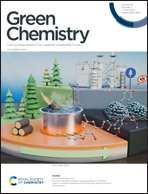One-pot cellulose etherification and self-crosslinking via a mild hydroxyl–yne click reaction in a homogeneous system†
Abstract
The chemical modification of cellulose via sustainable pathways is highly desirable for high performance cellulose derivatives. Herein, a novel one-pot method for the etherification and self-crosslinking of cellulose is demonstrated, for the first time, by applying the mild hydroxyl–yne click reaction that occurs in a homogeneous system. Besides the benzene rings and carbonyl groups, the conjugated C![[double bond, length as m-dash]](https://www.rsc.org/images/entities/char_e001.gif) C double bonds formed by the hydroxyl–yne click reaction were also introduced to the resulting cellulose phenyl propylene ketone ethers (CPPKs). Interestingly, the conjugated C
C double bonds formed by the hydroxyl–yne click reaction were also introduced to the resulting cellulose phenyl propylene ketone ethers (CPPKs). Interestingly, the conjugated C![[double bond, length as m-dash]](https://www.rsc.org/images/entities/char_e001.gif) C double bonds in CPPKs could crosslink via photo-dimerization reactions during the etherification of cellulose, forming chemically crosslinked CPPKs. Therefore, the CPPK films exhibited excellent mechanical properties and solvent resistance. The ultimate strength of CPPKs was 85.7 ± 1.5 MPa, 1.6 times higher than that of raw cellulose. Moreover, the CPPK films were stable in high-polarity solvents (DMSO, DMAc, and DMF) for 6 months. Furthermore, CPPKs not only exhibited excellent UV-shielding properties but also showed good UV self-reinforcing properties; both CPPK hydrogels and films displayed improved mechanical properties under UV irradiation. This work provides a sustainable one-pot method for etherification and self-crosslinking of cellulose in the homogeneous system, which imparts excellent stress, solvent resistance, UV-shielding, and UV self-reinforcement to cellulose, promoting high-value utilization of cellulose materials.
C double bonds in CPPKs could crosslink via photo-dimerization reactions during the etherification of cellulose, forming chemically crosslinked CPPKs. Therefore, the CPPK films exhibited excellent mechanical properties and solvent resistance. The ultimate strength of CPPKs was 85.7 ± 1.5 MPa, 1.6 times higher than that of raw cellulose. Moreover, the CPPK films were stable in high-polarity solvents (DMSO, DMAc, and DMF) for 6 months. Furthermore, CPPKs not only exhibited excellent UV-shielding properties but also showed good UV self-reinforcing properties; both CPPK hydrogels and films displayed improved mechanical properties under UV irradiation. This work provides a sustainable one-pot method for etherification and self-crosslinking of cellulose in the homogeneous system, which imparts excellent stress, solvent resistance, UV-shielding, and UV self-reinforcement to cellulose, promoting high-value utilization of cellulose materials.



 Please wait while we load your content...
Please wait while we load your content...